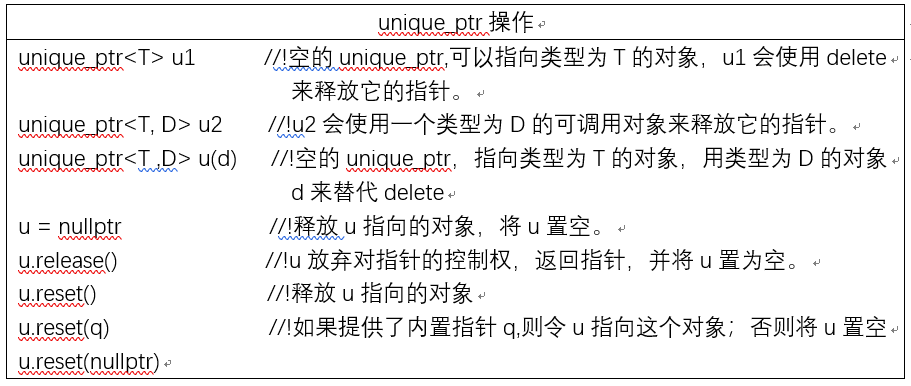一个unique_ptr"拥有“他所指向的对象。与shared_ptr不同,某个时刻只能有一个unique_ptr指向一个给定的对象。当unique_ptr被销毁时,它所指向的对象也被销毁。uniptr_ptr表达的是一种独占的思想。
初始化
#include <iostream>
#include <memory>
using namespace std;
//常规操作
int main(int argc, char *argv[])
{
unique_ptr<double> p1; //!可指向一个double的unique_ptr
unique_ptr<int> p2(new int(56)); //!p2指向了一个值为42的int
unique_ptr<string> pstr(new string("strtest"));
// unique_ptr<string> pstrCopy(pstr); //!error: 不支持对象的拷贝
unique_ptr<string> pstrAssin;
// pstrAssin = pstr //!error: uniptr不支持赋值
return 0;
}
unique_ptr一般操作

关于unique_ptr还支持哪些操作,在前面的博文中我也做了总结,请参考该篇文章中图表:https://www.cnblogs.com/wangkeqin/p/9351191.html
unique_ptr所有权转移
虽然我们不能拷贝赋值unique_ptr,但是可以通过调用release或者set将指针的所有权从一个(非const)unique_ptr转移给一个unique:
#include <iostream>
#include <memory>
using namespace std;
class TEST
{
public:
TEST(const string & name)
:_name(name)
{cout<<"TEST:"<<_name<<endl;}
TEST(const TEST & another)
{ _name = another._name;
cout<<another._name<<" copyStruct "<<_name<<endl;}
TEST & operator =(const TEST & another){
if(&another==this)
return *this;
this->_name=another._name;
cout<<another._name<<" copyAssin to "<<_name<<endl;
}
~TEST(){cout<<"~TEST:"<<_name<<endl;}
//private:
string _name;
};
//其他操作
int main()
{
unique_ptr<TEST> p1(new TEST("case_1"));
unique_ptr<TEST> p2(p1.release()); //!将所有权从p1转移到p2,p1现在指向NULL。
cout<<"++++++++++++++++++++++++"<<endl;
unique_ptr<TEST> p3(new TEST("case_2"));
p2.reset(p3.release()); //!p2释放了原来指向的内存,接受了p3指向的内存。
getchar();
}
传递unique_ptr参数和返回unique_ptr
不能拷贝unique_ptr的规则有一个例外:我们可以拷贝或者赋值一个将要被销毁的unique_ptr。其本质就是调用了移动拷贝和移动赋值;最常见的例子是从函数返回一个unique_ptr:
#include <iostream>
#include <memory>
using namespace std;
class TEST
{
public:
TEST(const string & name)
:_name(name)
{cout<<"TEST:"<<_name<<endl;}
TEST(const TEST & another)
{ _name = another._name;
cout<<another._name<<" copyStruct "<<_name<<endl;}
TEST & operator =(const TEST & another){
if(&another==this)
return *this;
this->_name=another._name;
cout<<another._name<<" copyAssin to "<<_name<<endl;
}
~TEST(){cout<<"~TEST:"<<_name<<endl;}
//private:
string _name;
};
//!例外:
//①返回一个即将被销毁的uniptr
unique_ptr<TEST> retDying(string param)
{
return unique_ptr<TEST>(new TEST(param));
}
//②返回一个局部对象;
unique_ptr<TEST> retTemp(string param)
{
unique_ptr<TEST> pTemp(new TEST(param));
return pTemp;
}
int main()
{
unique_ptr<TEST>ret1 = retDying("dying");
cout<<(*ret1)._name<<endl;
unique_ptr<TEST>ret2 = retTemp("temp");
cout<<(*ret2)._name<<endl;
getchar();
}
向后兼容:auto_ptr
标准库较早的版本包含了一个名为auto_ptr的类,它具有unique_ptr的部分特性,但不是全部。特别时我们在容器中保存auto_ptr,也不能从函数中返回auto_ptr。虽然auto_ptr仍然是标准库的一部分,但是编写程序时应该使用unique_ptr。
向unique_ptr传递删除器
类似于shared_ptr,unique_ptr默认情况下也是使用delete释放它指向的对象。与shared_ptr一样,我们可以重载一个unique_ptr中默认的删除器。但是unique_ptr管理删除器的方式与shared_ptr不同,其原因我们将在后面继续补充。
重载一个unique_ptr中的删除器会影响到unique_ptr类型如何构造(或reset)该类型的对象。与重载关联器的比较操作类似。我们必须在尖括号中unique_ptr指向类型之后提供删除器类型。在创建或者reset一个这种unique_ptr这种类型的对象时,必须提供一个指定类型的可调用对象:
#include <stdio.h>
#include <memory>
using namespace std;
void closePf(FILE * pf)
{
cout<<"----close pf after works!----"<<endl;
fclose(pf);
cout<<"*****end working****"<<endl;
}
int main()
{
// FILE * fp2 = fopen("bin2.txt", "w");
// if(!pf)
// return -1;
// char *buf = "abcdefg";
// fwrite(buf, 8, 1, fp2);
// fclose(fp2);
//______________________________________
// shared_ptr<FILE> pf(fopen("bin2.txt", "w"),closePf);
// cout<<"*****start working****"<<endl;
// if(!pf)
// return -1;
// char *buf = "abcdefg";
// fwrite(buf, 8, 1, pf.get()); //!确保fwrite不会删除指针的情况下,可以将shared_ptr内置指针取出来。
// cout<<"----write int file!-----"<<endl;
unique_ptr<FILE,decltype(closePf)*> pf(fopen("bin2.txt", "w"),closePf); //!使用了decltype类型推断
cout<<"*****start working****"<<endl;
if(!pf)
return -1;
char *buf = "abcdefg";
fwrite(buf, 8, 1, pf.get()); //!确保fwrite不会删除指针的情况下,可以将unique_ptr内置指针取出来。
cout<<"----write int file!-----"<<endl;
return 0;
}
使用unique_ptr管理动态数组
标准库提供了一个可以管理new分配动态数组的unique_ptr版本。为了用用一个unique_ptr管理动态数组,我们必须在对象类型后面跟一对空方括号;如此,在unique对象销毁的时候,也可以自动调用delete[ ]而非delete来完成内存的释放。
#include <iostream>
#include <memory>
using namespace std;
class ArrTest
{
public:
ArrTest(){
static int i = 0;
_i = i;
cout<<" ArrTest()"<<":"<<i++<<endl;
}
~ArrTest(){
static int i = 0;
cout<<"~ ArrTest()"<<":"<<i++<<endl;
}
int _i;
};
int main()
{
unique_ptr<ArrTest[]> p(new ArrTest[10]);
cout<<p[4]._i<<endl; //!获取某个元素值,警告:不要使用越界的下标,unique_ptr也是不检查越界的。
p.reset();
return 0;
}

